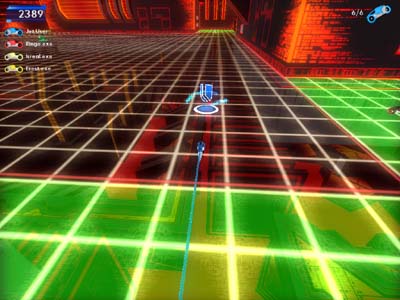Image Quality Analysis Fall 2003: A Glance Through the Looking Glass
by Derek Wilson on December 10, 2003 11:14 PM EST- Posted in
- GPUs
Color and Alpha
There is an incredible volume of technology that goes into producing a 3D scene in real-time. Due to the vast amount of information on this topic, we will only be covering the points necessary to help understand the visual differences we saw in the games that we tested. And what better place to start than one of the most basic aspects of any image: color.In a computer, the color of a pixel is determined by four values: red, green, blue, and alpha. Red, green, and blue are the primary colors of light and can be combined in different intensities to create millions of other colors. The alpha value is a specification of how opaque or translucent a color should be, which allows for some very complex layering effects and translucent objects that can't be achieved with color alone (this is called alpha blending).
 |
The translucent floor in this scene is a good
example of what alpha blending can do. (Click to enlarge.) |
Using a lot of alpha blending can bring just about any GPU to a crawl. In light of the limitations of human visual perception and the accuracy of color representation in a computer, very translucent objects can be discarded, since the alpha blending won't significantly change the color of the final result. It is common practice in the world of 3D graphics to put a threshold on how opaque something needs to be before it is considered for drawing at all. This really helps to speed up rendering, and (ideally) doesn't impact the experience of the game at all.










35 Comments
View All Comments
retrospooty - Thursday, December 11, 2003 - link
I have been visiting Anandtech for well over 4 years , and I have often exclaimed how thorough, fair, and unbiased this site is to others...This is the first article I have ever read here that I think is complete poop. I cannot beleive that in any fair IQ test Nvidia came anywhere close to ATI. Either the author is not being honest, or is color blind. Anyone with eyeballls can compare the two and see that ATI is much sharper, and vibrant especially with AA... Nvidia is WAY blurry.
I am very VERY dissapointed in this. :(
TheGoldenMenkey - Thursday, December 11, 2003 - link
Excellent article. I would much rather be taught why things are different than be showed some differences in rendering and then have someone declare which one is cheating. Thanks for teaching us enough to let us come to our own conclusions. Keep up the good work AT.tazdevl - Thursday, December 11, 2003 - link
Better look @ that... then we might have something to discusshttp://www.anandtech.com/video/showdoc.html?i=1931...
dvinnen - Thursday, December 11, 2003 - link
Artical seemed fair and unbias to me. Your AA and AF question is odvious. Look at the URL of the png file. It clearly states what is on.It seems they have cleaned up there DX9 proformance, but they still treat synthitic benchmarks badly. Most recintly the 3DMark03 patch a month ago and how they handeled the media (PR on one side of the pond said one thing, on the other saide, they said another)
tazdevl - Thursday, December 11, 2003 - link
So Derek to you own stock in nVIDIA? Did Brian Burke write this for you?Were AA and Aniso used in all tests or a few? Which ones? What modes are we comparing against which benchmarks?
Ever thought that BOTH nVIDIA and ATI can fix the outstanding instead of just nVIDIA?
I swear, every since Anand got caught up in the whole NV30 fiasco, the site's credibility is worth absolutely squat when it comes to nVIDIA.
I'm not saying ATI is without faults, but let's try to appear unbiased at a minimum in the article.